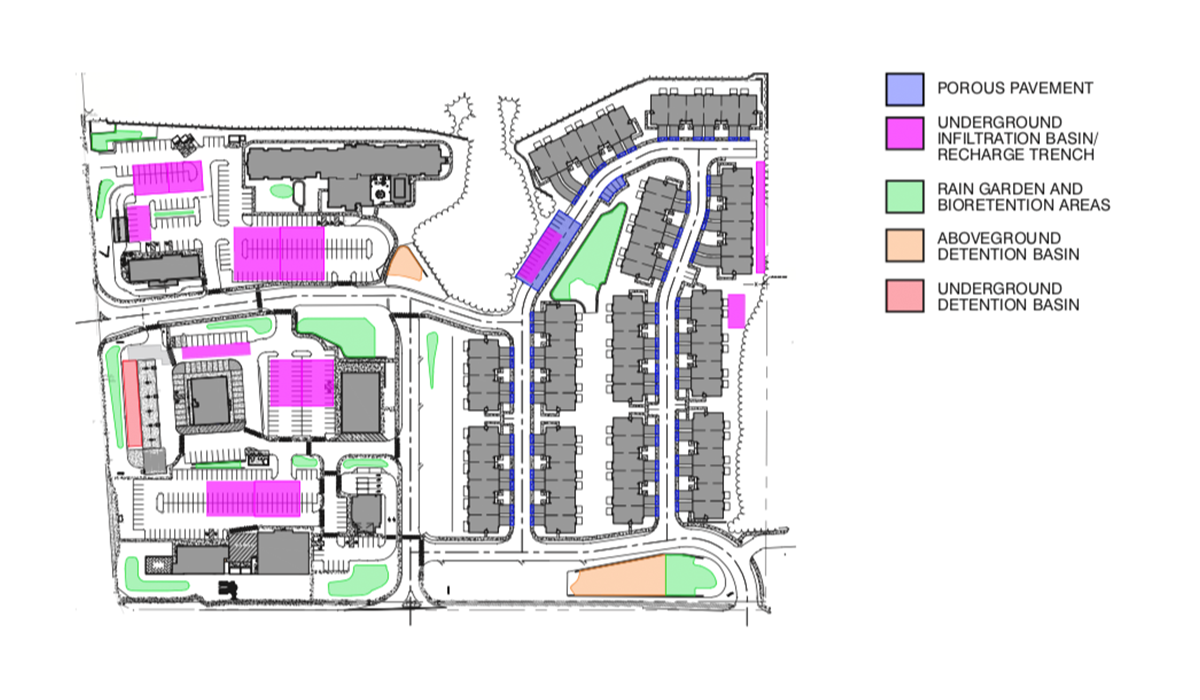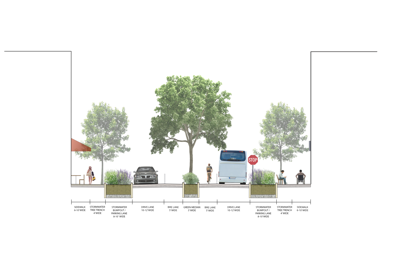The purpose of these “side-by-side” concept plans is to illustrate the practical effect and implementation of the new stormwater rules and updated BMP Manual. There are two fundamental concepts to understand:
- Decentralization is key. Stormwater management BMPs should be distributed around a site near where stormwater runoff is generated in order to minimize the accumulation of stormwater prior to treatment and mitigation. Groundwater recharge and water quality standards must be met using these distributed BMPs (see Table 5-1).
- Infiltration through green infrastructure now “counts.” The prior BMP Manual guidelines prohibited counting infiltration in demonstrating compliance with the quantitative standards. Under the prior rule, the only standard accepted method to account for BMP volume was by hydraulically routing each BMP. Under the new rule, all stormwater BMPs can account for infiltration during a storm event, thereby increasing a BMP’s ability to reduce water quantity and reducing the land area used for stormwater management.
The following side-by-side comparisons illustrate how green infrastructure could affect site design and how municipalities should adjust to their approach to stormwater design in order to review and approve private projects and design public projects.
Click through to each comparison and use the slider tool to explore the differences between old and new design options.
Mixed-Use Side-by-Side Comparison
Green Infrastructure in Mixed-Use Development: How the Changes to the Stormwater Rule (NJAC 7:8; Operative March 2021) Affect an Example of Mixed-Use Development and What This Means for Municipal Stormwater Review
Use the comparison slider tool below to explore the differences between this mixed-use property before the Stormwater Rule change and after.
Before:
Under the updated stormwater rules (operative March 2021), traditional development designs in towns and cities will have to be reimagined. These rules rely on a model of dispersed green stormwater infrastructure around the site. The March 2021 rule update allows designers to account for volume reduction through infiltration, which reduces costs because it reduces the size of systems. Municipalities will have to adjust to this approach to stormwater design in order to review and approve private projects as well as design public projects.
This comparison demonstrates how the March 2021 stormwater rules can impact a development project. The property shown was subject to a variety of environmental constraints, transportation needs, and development yield.
The “before” design relies heavily on subsurface infiltration systems to manage increases in stormwater runoff. These systems provide no value to the site beyond stormwater management.
Traditional systems largely rely on structural strategies for managing runoff (large surface detention basins, subsurface infiltration systems, inlets, pipes and other “gray” infrastructure). The large size of these features can be partially attributed to the fact that infiltration did not “count” in routing calculations before the change in stormwater rules. All systems were assumed to have no infiltration and had to be designed to detain and release all runoff.
After:
The “after” design reveals the benefits of the March 2021 rule as it relates to infiltration. It takes greater advantage of green infrastructure practices in order to reduce the size of gray infrastructure systems. In this example:
- “Counting” infiltration decreases the size of subsurface infiltration systems, as shown in the smaller pink-colored footprints.
- The aboveground detention systems (shown in orange) are replaced with bioretention areas (shown in green) to improve infiltration capabilities.
- The areas dedicated to porous pavement (shown in blue) and underground detention systems (shown in red) remain the same size.
Increased use of bioretention systems or other green infrastructure BMPs could be used to further reduce the size of gray infrastructure systems. Municipalities will benefit from the dispersed, green infrastructure techniques through the increased use of vegetative practices that add aesthetic and environmental value to developments.
Note that both designs incorporate a variety of techniques for managing runoff that are dispersed throughout the site, as opposed to more traditional stormwater systems that are centralized. Although the “before” and “after” designs are similar in this respect, municipalities should encourage projects that imitate the “after” design for the benefits discussed above. Reviewers should be aware of which practices are permitted under the 2021 rule and which practices require variances or waivers. Understanding the advantages of “counting” infiltration on a project will also help municipalities to reduce construction costs on public projects and capitalize on green infrastructure as public amenities.
Green Streets: A Design Solution for Stormwater and People
Green Infrastructure in Streetscape and Roadway Projects: How Changes to the Stormwater Rule (NJAC 7:8; Operative March 2021) Affect Streets
Use the comparison slider tool below to explore the differences between this street project before and after green infrastructure is introduced.
Before:
The updated stormwater rules (effective March 2021) provide opportunities to reimagine municipal infrastructure through the integration of green infrastructure. The March 2021 rules include updates to permitting processes and compliance requirements that may apply to projects in streets, also known as the municipal right-of-way. The new rule provides guidance on the design of green infrastructure that can be used to help meet these standards.
Under this traditional street design, streetscapes are imagined one-dimensionally and vehicular traffic is prioritized. Integration of traditional gray stormwater management infrastructure within rights-of-way is challenging as large detention systems cannot be easily included in a downtown center or city block. Underground detention systems and pipe networks beneath roadways can be costly for municipalities. In this example, there are limited opportunities for biking and walking because the street does not have a designated bike lane or an attractive sidewalk. Pedestrian safety measures are limited to speed bumps, crosswalks, and signage. Traditional roadway design provides limited aesthetic value and is typically less variable in the layout of sidewalks, bike lanes, drive isles, and occasional street trees.
After:
Green streets organize traditional vehicular, bike, parking, and pedestrian lanes through the incorporation of green infrastructure practices that manage stormwater and filter trash, debris, and sediment from adjacent roadways. In this example:
- The green street includes stormwater bump outs on both sides as well as a green median.
- The green street also replaces street trees with stormwater tree trenches.
- The decreased vehicular traffic lanes integral to the design of green streets acts as a traffic calming measure to prevent speeding.
- Adding bike lanes makes the streets safer for cyclists.
- Pedestrians are safer as well, thanks to calmer traffic and shorter crossings.
- Green streets reduce the area of asphalt drive lanes, which minimizes the amount of stormwater a public project must manage and potentially reduces costs.
- Implementing best practices such as low-growing plants helps to maintain sight lines and promote safe traffic patterns.
In addition to improving stormwater management and transportation systems, green streets can create the added benefit of a beautiful municipality and attract business owners, renters, and homeowners to an area. Incorporating vegetation along pedestrian walkways, bike lanes, and vehicular lanes can improve public health through increased physical activity, improved air and water quality, and cooler temperatures—creating an overall engaging experience. Green streets make economic sense, not only providing benefits to private property owners through increased property values, but also providing municipalities with large scale reductions in public health and flood damage repair investments.
Green street design can not only benefit new developments subject to the March 2, 2021 stormwater rules, it can also bring the same benefits to existing roadways in need of redevelopment. Plans for green street development should consider the specific transit and pedestrian needs of a community while accounting for the site-specific needs of each block and intersection. Good design requires coordination between designers, traffic engineers, municipal health departments, and emergency services to make sure all requirements for access, maintenance, and visibility are maintained.

